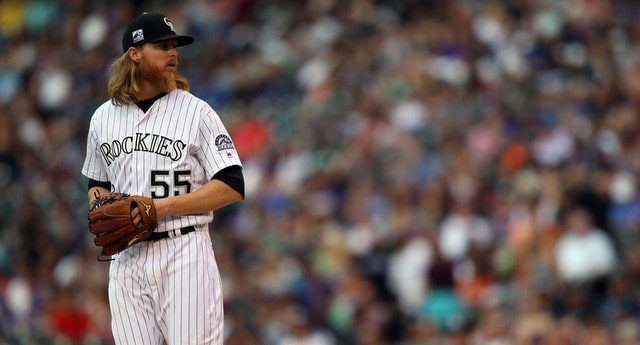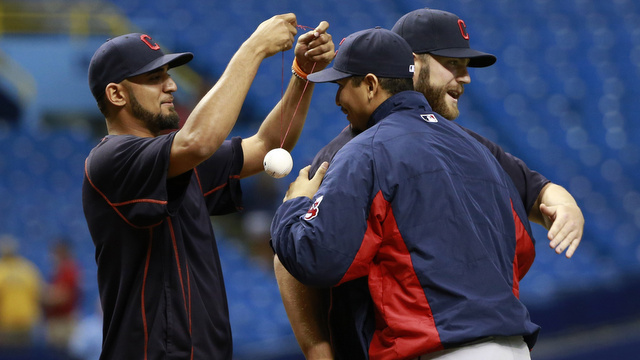
Over the weekend the Rockies made some headlines when they optioned nominal ace and two-time Opening Day starter Jon Gray down to Triple-A. When you lead the league in hits (108) and earned runs (59) allowed, and pitch to a 5.77 ERA in 17 starts and 92 innings, you’re liable to find yourself in the minors. Even when you call Coors Field home and the ballpark undoubtedly inflates your numbers.
“This was the right time to get Jon to Triple-A to work on some things, not so much mechanically, but mentally, and to realize the inconsistencies that have been happening this season,” said Rockies manager Bud Black to Patrick Saunders. “We’ve got to try to get those things straightened out. We felt that at this time it was best for him to work out some of these things in the minor leagues.”
Gray didn’t bemoan the Triple-A assignment — “I am going to do whatever I can to get right,” he said to Saunders — which is good, but the fact remains he had to be sent to the minors. The Rockies, really for the first time in franchise history, have an impressive collection of young starters. Gray is the centerpiece and things are not going according to plan this season. It’s a setback for a team that went to the NL Wild Card Game last year. No doubt.
In terms of run prevention, Gray has stunk. When it comes to getting strikeouts (28.9%) and limiting walks (7.0%) and homers (1.08 HR/9), Gray has been pretty great. At the time of his demotion, his 3.09 FIP was 14th best among the 89 pitchers with enough inning to qualify for the ERA title, just ahead of Corey Kluber (3.29 FIP). One-hundred-and-two pitchers have thrown at least 400 innings since 2015, and among those 102, Gray has the …
- 16th lowest FIP (3.38).
- 17th best strikeout rate (25.8%).
- 12th highest ERA (4.77).
It would be easy — and not entirely unfair — to blame Coors Field for the inflated ERA, but, in his career to date, Gray has a 4.75 ERA (3.33 FIP) at home and a 4.67 ERA (3.41 FIP) on the road. Hmmm. We’ve seen plenty of pitchers struggle to keep runs off the board despite sexy peripheral numbers. Michael Pineda is a great example. Big Mike had a 4.16 ERA (3.65 FIP) during his time in pinstripes.
To date, the discrepancy between Gray’s run prevention numbers and fielding independent numbers is extreme. How extreme? Since the mound was lowered in 1969, there have been 1,422 pitchers to throw at least 400 innings in the big leagues. The biggest differences in ERA and FIP:
- Jon Gray: 1.33 ERA-FIP
- Esmil Rogers: 1.14 ERA-FIP
- Jose Silva: 1.09 ERA-FIP
- Bob Veale: 1.02 ERA-FIP
- Dana Eveland: 1.02 ERA-FIP
Esmil Rogers! But yeah, the difference between Gray’s ERA and FIP is historically huge. Coors Field plays a role in that, undoubtedly. Given the home/road splits, it would be wrong to blame the ballpark exclusively for Gray’s run prevention issues, however. The Rockies certainly feel that way. Otherwise they wouldn’t have sent him to Triple-A. Black did mention Gray needed to work on some things “mentally,” after all.
That is all a long way of saying Gray is a very talented — you don’t miss this many bats in the big leagues without talent — but also inconsistent and enigmatic. It’s gotten to the point where the Rockies don’t believe Gray can be fixed in the big leagues, so they sent him to the minors, where he can work on things in a low pressure environment where wins and losses don’t matter. Gray’s issues this year have been mostly limited to pitching with men on base:
| IP | FIP | K% | BB% | GB% | BABIP | |
|---|---|---|---|---|---|---|
| Bases Empty | 53.1 | 1.93 | 35.7% | 4.8% | 49.6% | .405 |
| Men on Base | 38.2 | 4.69 | 20.3% | 9.9% | 41.7% | .367 |
The Rockies do deserve some share of the blame for Gray’s struggles this season. His .386 BABIP is the highest in baseball — Lance Lynn is a distant second at .341 — and that’s the kind of thing that happens when you play in a ballpark with the second most outfield square footage in baseball and field the game’s second worst defensive outfield (-24 DRS). Give the dude a little help!
Is some frustration setting in? Yeah, I imagine so. For both Gray and the Rockies. After last season (3.67 ERA and 3.18 FIP) I’m sure the club was hoping Gray would take that next step and become one of the game’s premier pitchers. It hasn’t happened. Are they frustrated enough to make him available in trades? Well, that’s another question entirely. On one hand, I’m sure the Rockies don’t want to sell low. On the other, this is the team paying Ian Desmond and Gerardo Parra a combined $32M this season, so maybe their decision-making process isn’t the best?
The Yankees, as you know, are looking for rotation help prior to the July 31st trade deadline. They want short-term and long-term help. Someone who can help them win this year and, preferably, also someone who can pair up with Luis Severino to lead the rotation in the future. Jacob deGrom would be ideal, in my opinion. That’s probably not happening though. Gray is 26 years old, he’s a former tippy top prospect, and he’s under control through 2021. If the Rockies are open to moving him, the Yankees would be foolish not to make a call.
Two things to keep in mind here. One, the Yankees are where they are right now partly because they’ve pursued highly talented players who fell out of favor with their former teams. Didi Gregorius and Aaron Hicks are the big success stories. Nathan Eovaldi also fit into this category, though he didn’t work out quite as well. Point is, a very talented player who’s yet to come into a own and is frustrating his team is a prime Yankees’ trade target.
And two, the Yankees do have a bit of a history with Gray. They drafted him following his freshman year at a junior college and offered him a healthy $500,000 bonus to sign, but he declined and transferred to Oklahoma. Two years later the Rockies made him the third overall pick in the 2013 draft. The people running the amateur scouting department then are still running it now. At one point the Yankees saw something in Gray they really liked — it’s not every year a tenth rounder is offered half-a-million bucks — and chances are he still has fans in the organization.
Gray fits the typical Yankees’ profile. He’s big, he throws hard, he misses bats, and his current team might be souring on him. There are two questions now. One, will the Rockies trade him? Who knows. Everyone is available at the right price, and the right price for the Rockies might not be the right price for the Yankees. And two, is Gray fixable? I sure hope so. He’s still so young and his stuff is so good …
To me, Gray seems like a fantastic change-of-scenery candidate. Get him out of Coors Field full-time and get him into a new organization with a fresh set of eyes — that means both coaches and analytics folks — and see where it takes him. If the Rockies are getting frustrated with Gray and are open to moving on, the Yankees have the pieces to make a deal happen. In all likelihood, this is all hypothetical. Strange things happen at the deadline though, and Gray becoming available would represent an opportunity to nab elite talent at a potentially reduced price.
